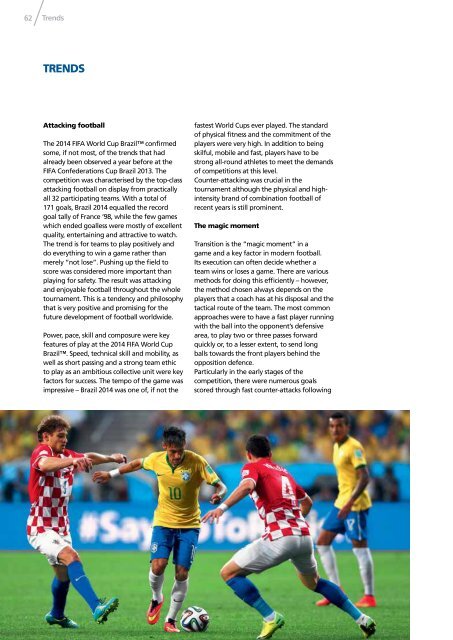2014fwc_tsg_report_15082014_neutral
2014fwc_tsg_report_15082014_neutral
2014fwc_tsg_report_15082014_neutral
Create successful ePaper yourself
Turn your PDF publications into a flip-book with our unique Google optimized e-Paper software.
62<br />
Trends<br />
TRENDS<br />
Attacking football<br />
The 2014 FIFA World Cup Brazil confirmed<br />
some, if not most, of the trends that had<br />
already been observed a year before at the<br />
FIFA Confederations Cup Brazil 2013. The<br />
competition was characterised by the top-class<br />
attacking football on display from practically<br />
all 32 participating teams. With a total of<br />
171 goals, Brazil 2014 equalled the record<br />
goal tally of France ‘98, while the few games<br />
which ended goalless were mostly of excellent<br />
quality, entertaining and attractive to watch.<br />
The trend is for teams to play positively and<br />
do everything to win a game rather than<br />
merely “not lose”. Pushing up the field to<br />
score was considered more important than<br />
playing for safety. The result was attacking<br />
and enjoyable football throughout the whole<br />
tournament. This is a tendency and philosophy<br />
that is very positive and promising for the<br />
future development of football worldwide.<br />
Power, pace, skill and composure were key<br />
features of play at the 2014 FIFA World Cup<br />
Brazil. Speed, technical skill and mobility, as<br />
well as short passing and a strong team ethic<br />
to play as an ambitious collective unit were key<br />
factors for success. The tempo of the game was<br />
impressive – Brazil 2014 was one of, if not the<br />
fastest World Cups ever played. The standard<br />
of physical fitness and the commitment of the<br />
players were very high. In addition to being<br />
skilful, mobile and fast, players have to be<br />
strong all-round athletes to meet the demands<br />
of competitions at this level.<br />
Counter-attacking was crucial in the<br />
tournament although the physical and highintensity<br />
brand of combination football of<br />
recent years is still prominent.<br />
The magic moment<br />
Transition is the “magic moment” in a<br />
game and a key factor in modern football.<br />
Its execution can often decide whether a<br />
team wins or loses a game. There are various<br />
methods for doing this efficiently – however,<br />
the method chosen always depends on the<br />
players that a coach has at his disposal and the<br />
tactical route of the team. The most common<br />
approaches were to have a fast player running<br />
with the ball into the opponent’s defensive<br />
area, to play two or three passes forward<br />
quickly or, to a lesser extent, to send long<br />
balls towards the front players behind the<br />
opposition defence.<br />
Particularly in the early stages of the<br />
competition, there were numerous goals<br />
scored through fast counter-attacks following


